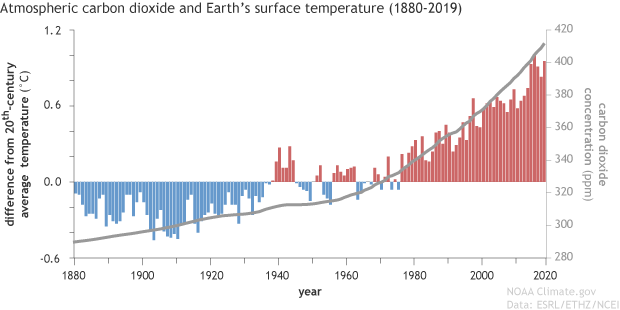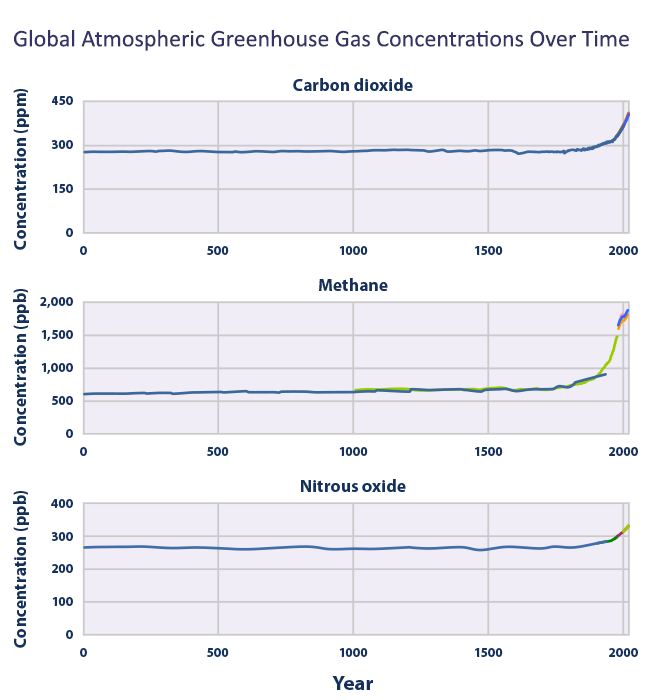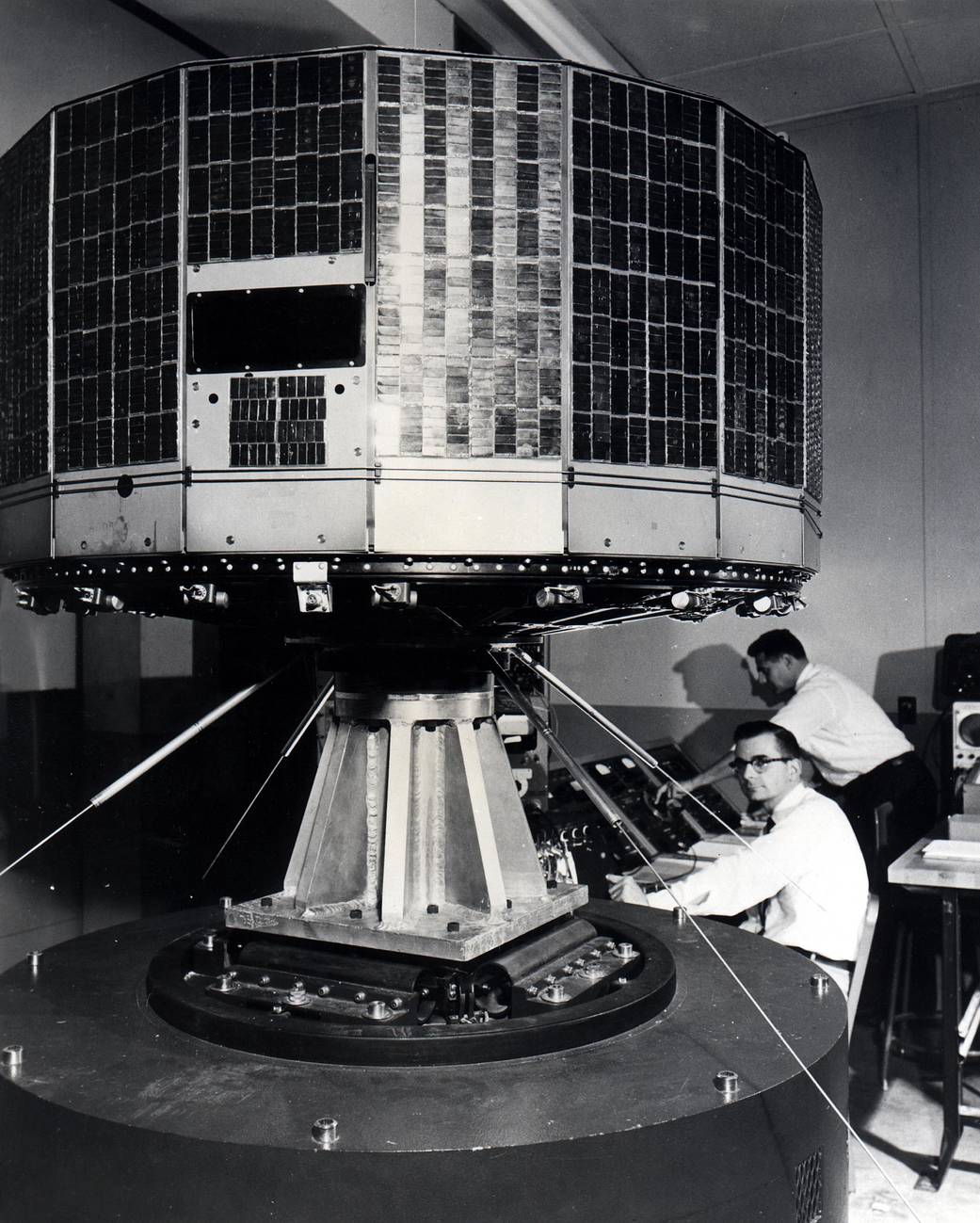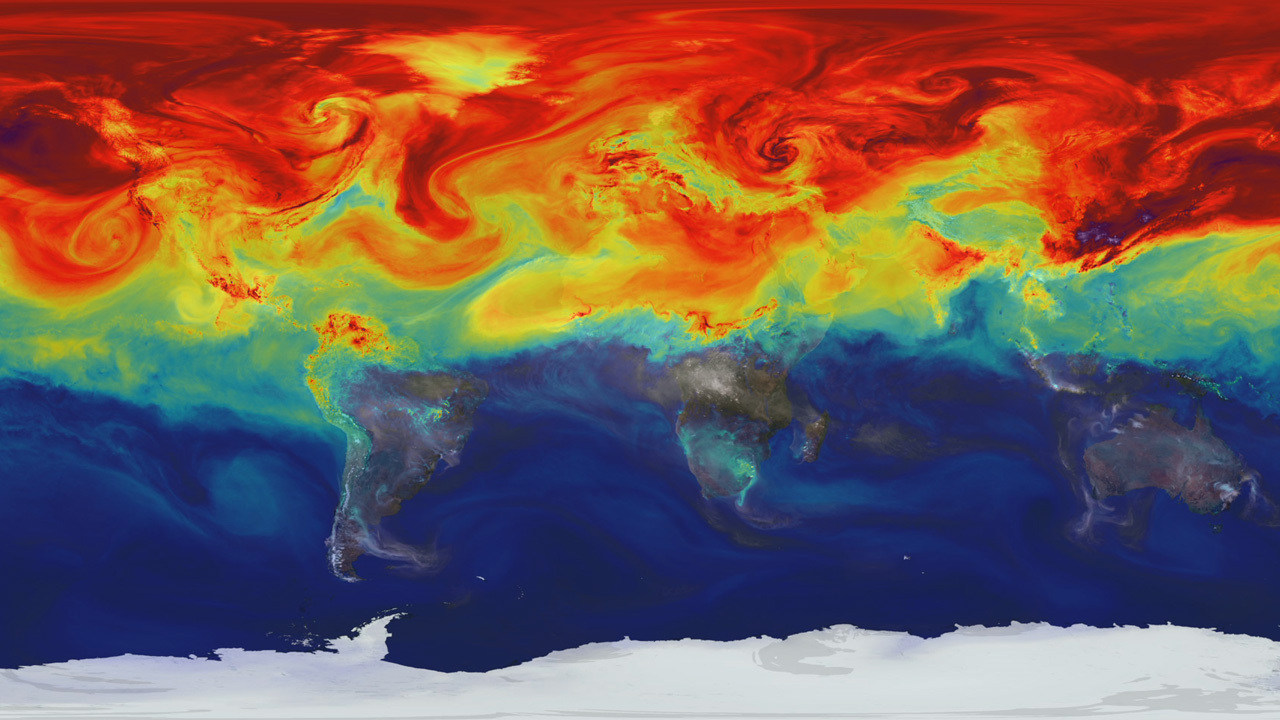Climate change: Causes and effects
Earth is changing and we're already feeling the effects.

Climate change is the long-term, continued shifting of temperatures and weather patterns on planet Earth; an evolution driven by human activities.
In the over 4.5 billion years that Earth has existed, orbiting the sun in the small stellar neighborhood we call home, our planet has gone through many changes. But humans have had a profound impact.
Burning fossil fuels (coal, oil and gas) produces "greenhouse gasses" like carbon dioxide. These gases, which are produced in industries including agriculture, energy and more, have earned this name because once in Earth's atmosphere, they trap heat against our planet, preventing it from escaping and creating a warming "greenhouse effect."
Related: Satellites are critical to fighting the climate crisis, scientists say
"Observations throughout the world make it clear that climate change is occurring, and rigorous scientific research demonstrates that the greenhouse gases emitted by human activities are the primary driver," a statement on climate change from 18 scientific associations reads, according to NASA.
With the dawn of the industrial revolution, humans began producing more significant amounts of greenhouse gasses. Time went on and technology progressed and, by the time we reached the mid-20th century, human activity was pushing climate change forward at an unprecedented rate.
While it has been hotly debated, it has been proven that human activities are the primary drivers of climate change. However, the good news is that while human activity fuels climate change, human activity can change and we can affect how climate change continues to progress.
"Scientific evidence for warming of the climate system is unequivocal," according to the Intergovernmental Panel on Climate Change.
Related: Earth Day: What is it and why does it matter?
Global warming?
When climate change is discussed, the term "global warming" is often used, and the two are commonly used interchangeably. It can be confusing what the difference between the two is, or if there even is a difference.
In short, global warming refers to the long-term warming of Earth, and climate change is a term that includes global warming as well as the other changes on our planet like sea level rise, increasing natural disasters, shrinking glaciers, etc.
In other words, both terms are correct, but climate change describes the larger picture of what's happening on planet Earth.
Scientific evidence for climate change
Climate change is a phenomenon that was discovered over 100 years ago and, in recent decades, scientists have continued to collect overwhelming evidence of its existence and progression.
"A consensus on climate change and its human cause exists. Multiple studies published in peer-reviewed scientific journals show that human activities are the primary cause of the observed climate-warming trend over the past century."

Still, some still deny its existence to this day. So, let's break down a few examples of studies that have built our knowledge of climate change and explore some of the scientific evidence that bolsters our growing understanding:
*Note: This is just a sample of climate change research. The field of climate science includes many additional studies and pieces of "evidence."
- As one study, published in 2020, found using data from NASA's Gravity Recovery and Climate Experiment, ice sheets in Greenland and the Antarctic have lost an average of 279 billion tons of ice per year between 1993 and 2019 and Antartica lost about 148 billion tons of ice per year.
- Earth's surface continues to warm and recent global temperatures are the hottest seen in over 2,000 years, according to NASA.
- The annual IPCC climate report details how climate change has progressed over the past year and what can be predicted based off of recent data. The 2022 IPCC report shows the most recent findings, including how the effects of climate change are happening faster than previously expected.
- Some of the earliest scientific evidence for the greenhouse effect and how it works came in 1824 when Joseph Fourier calculated that Earth, at its size and distance from the sun, should be colder than it is. This led to the eventual conclusion that our atmosphere acts like a blanket insulating the planet.
- Global sea levels are continuing to rise and recent rates are "unprecedented over the past 2,500-plus years," according to NASA.
One of the ways that scientists continue to track and study climate change is by observing its effects, as we have already seen its impact around the world.
Effects of climate change
Climate change is not a future possibility that we are working to stave off. The effects of climate change, explained below, have already begun and we are already seeing the devastating, deadly toll they can take. As climate change progresses, these effects will intensify.
With greenhouse gasses blanketing Earth and trapping heat against our planet, warming it over time, hotter temperatures are a certain effect of climate change.
Sea levels will also keep rising. As the ocean absorbs a lot of Earth's heat, warming temperatures will see see levels rising as water expands as it warms. Additionally, warming temperatures continue to melt ice sheets, further adding to these rising levels.
Rising sea levels will threaten coastal and island communities, whose lives will be further endangered as another effect of climate change is increasing storms. With the progression of climate change, storms will become both more frequent and extreme. Rising temperatures leads to more water evaporating and becoming precipitation leading to extreme flooding and the warming ocean will drive more and more intense cyclones, hurricanes and typhoons.
And, just as storms will get worse, so will drought. With warming temperatures, droughts will continue to increase around the world, drying up drinking water sources and water for crops. Droughts can also spark massive sand and dust storms.
Related: The top 10 views of Earth from space
The increase in extreme weather events and changes around the world will have a massive impact on human health.
"Climate change is the single biggest health threat facing humanity," according to the United Nations.
The effects of climate change will continue to worsen human health through air pollution, disease, hunger, displacement, increasing poverty and more.
With climate change, the world's oceans will also absorb more carbon dioxide; this will make the oceans more acidic and, therefore, dangerous to marine life and coral reefs. But marine species are not the only wildlife affected by climate change.
"Exacerbated by climate change, the world is losing species at a rate 1,000 times greater than at any other time in recorded human history," according to the United Nations.
Climate change: Causes
It's true that Earth's climate has fluctuated throughout history.
Within the last approximately 650,000 years, our planet has experienced seven cycles of glacial advance and retreat, according to NASA. This included the sudden end of the last ice age about 11,700 years ago, which is thought of as the beginning of the "modern climate era," and human civilization, NASA added.
These natural climate changes throughout Earth's history are mainly explained by small shifts in our planet's orbit that have, at times, caused Earth to be exposed to more (or less) solar energy.
But natural fluctuations are not why we are in what some describe as a "climate crisis" now. "Natural processes, such as changes in the sun's energy and volcanic eruptions, also affect the earth's climate. However, they do not explain the warming that we have observed over the last century," according to the U.S. Environmental Protection Agency.
It continues to be the overwhelming scientific consensus that human activity is the primary driver of climate change and its effects.
Humans have existed as "modern homo sapiens" on Earth for at least 200,000 years, scientists think. But, around 1760, things changed drastically with the Industrial Revolution, a time period lasting through about 1840 during which manufacturing processes started using larger, mechanized systems and factories to produce on bigger scales. Humans started burning more and more fossil fuels like coal, oil and natural gas.
"Since the Industrial Revolution, human activities have released large amounts of carbon dioxide and other greenhouse gases into the atmosphere, which has changed the earth’s climate," according to the U.S. Environmental Protection Agency.
Since the dawn of the industrial age, humans have continued to expand industrial production and, at the same time, our ability to transport goods around the globe has also grown tremendously. But, while technology has blossomed, fossil fuels still remain the most widely-used energy source.
In the graph below, you can see greenhouse gas emissions over the last 2,000 years with a distinct, visible spike beginning around the start of the industrial era.

The economic sectors that contribute the most greenhouse gas emissions, as reported in 2020, are transportation followed by electricity, industry, commercial & residential and agriculture, according to a report from the EPA. (Additional emissions are attributed to land use and forestry, the report added.)
The report further shared that, in total, the total greenhouse gas emissions in 2020 was equivalent to 5,981 million metric tons of carbon dioxide.
There are a variety of greenhouse gases that humans produce. The main culprits are carbon dioxide, which can last between 300 and 1,000 years in the atmosphere, and methane. While methane doesn't last quite as long in our atmosphere, it has over 80 times the warming power of carbon dioxide, according to the Environmental Defense Fund.
Climate from space

While conversations about outer space often center around things like black holes, exoplanets or the search for extraterrestrial life, space is one of our most valuable resources for studying Earth and its changing climate.
From the vantage point of outer space, satellites in orbit around our planet can get a uniquely comprehensive view.
NASA launched the world's first full-scale meteorological satellite, the Television Infrared Observation Satellite (TIROS) I in 1960. Since then, there have been dozens upon dozens of Earth-monitoring government satellites to launch to Earth orbit, with over 80 missions active at this moment. That is in addition to commercial Earth-orbiting satellites as well, a number which continues to grow as the commercial space sector booms.
The future

With temperatures on the rise as industry continues to generate greenhouse gasses, it's clear that climate change is already creating serious consequences for us humans on Earth. But what are we doing about it, and can we fix it?
One major misconception about climate change is that we can't do anything about it and we aren't doing anything about it. While it is an immensely challenging global crisis, people around the world are already working hard to develop solutions.
A major milestone in the fight against climate change was what's known as the Paris Agreement, also called the Paris Accords or the Paris Climate Accords. Adopted in 2015 and effective as of Nov. 4 2016, this is an international treaty on climate change.
The agreement "aims to substantially reduce global greenhouse gas emissions in an effort to limit the global temperature increase in this century to 2 degrees Celsius above preindustrial levels, while pursuing the means to limit the increase to 1.5 degrees," according to the Natural Resources Defense Council.
In other words, nations signing this treaty agree to take measures to try and reduce greenhouse gas emissions enough to keep temperatures from warming to a significant extent.
Also, the United Nations lists climate action among its sustainable development goals, though climate change will additionally have an impact on other SDGs from the UN including health, clean water, affordable and clean energy, poverty, hunger and more.
These international efforts have been paralleled by increased awareness and understanding of climate change around the globe. This has sparked interest in finding creative solutions to minimize the extreme potential of climate change and its deadly effects.
Additional resources
Keep up to date with climate change news and initiatives with ESA's climate office. Learn more about climate change with this article from the Natural Resources Defense Council. Calculate your carbon footprint with this environmental impact calculator and receive tips on how to reduce your impact.
Bibliography
- United Nations. Causes and effects of climate change. United Nations. Retrieved May 3, 2022.
- National Academy of Sciences. (2020). Climate change: Evidence and causes: Update 2020. The National Academies Press, Washington, DC, p. 5. doi: 10.17226/25733
- NASA. “Scientific Consensus: Earth’s Climate Is Warming.” Climate Change: Vital Signs of the Planet, NASA, Jan. 8, 2019.
- IPCC (2013). Climate change 2013: The physical science basisEXITEXIT EPA WEBSITE. Working Group I contribution to the fifth assessment report of the Intergovernmental Panel on Climate Change[Stocker, T.F., D. Qin, G.-K. Plattner, M. Tignor, S.K. Allen, J. Boschung, A. Nauels, Y. Xia, V. Bex & P.M. Midgley (eds.)]. Cambridge University Press, Cambridge, United Kingdom and New York, NY, p. 869.
- Tollefson, Jeff. “Climate Change Is Hitting the Planet Faster than Scientists Originally Thought.” Nature, Feb. 28, 2022.
Join our Space Forums to keep talking space on the latest missions, night sky and more! And if you have a news tip, correction or comment, let us know at: community@space.com.
Get the Space.com Newsletter
Breaking space news, the latest updates on rocket launches, skywatching events and more!

Chelsea “Foxanne” Gohd joined Space.com in 2018 and is now a Senior Writer, writing about everything from climate change to planetary science and human spaceflight in both articles and on-camera in videos. With a degree in Public Health and biological sciences, Chelsea has written and worked for institutions including the American Museum of Natural History, Scientific American, Discover Magazine Blog, Astronomy Magazine and Live Science. When not writing, editing or filming something space-y, Chelsea "Foxanne" Gohd is writing music and performing as Foxanne, even launching a song to space in 2021 with Inspiration4. You can follow her on Twitter @chelsea_gohd and @foxannemusic.










